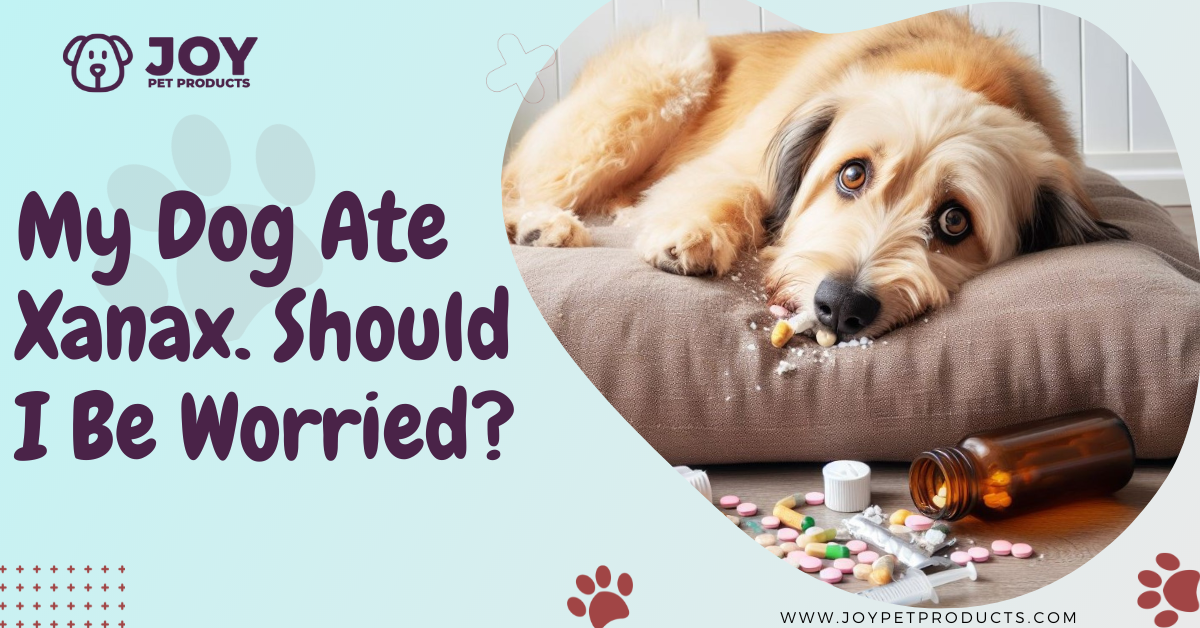Xannies. Chill Pills. Xanbars. Totem Poles.
Whatever you know them as, Xanax pills are one of the most common medications in the world. Created to help humans with anxiety and as a sleep aid, dogs have been known to accidentally eat one or multiple pills sitting on the bedside table.
What do you do if one day you suddenly find your dog ate Xanax while you were away?
Luckily, just like birth control pills, the margin of safety is very high and Xanax is relatively difficult to overdose on, even for dogs. This means that your pup likely won’t suffer any long standing negative health effects- though it may be a bit drowsy and cruisy for a while.
Nevertheless, overdoses can happen, especially if your dog was able to get its paws on a full bottle. If it has ingested one too many pills, your dog may begin to show signs of drug toxicity- in which case it would be a good idea to get it to the vet as soon as possible for treatment and observation.
What Is In Xanax?

Xanax is the brand name of the generic drug Alprazolam. It is a benzodiazepine which is a class of agents that work by attaching to certain receptors in the brain and central nervous system, making them less sensitive to stimulation. This causes it to have a calming effect and reduces anxiety for the user.
Can Xanax Be Used On Dogs?
Xanax, or alprazolam, is one of those medications that are prescribed both for human and animal use. It is commonly used in veterinary medicine to have the same calming effect on dogs as on people.
It has sedative and muscle-relaxant qualities which can help to relieve anxiety in canines regardless of the situation.
For example, a vet may give Xanax to a dog who gets overly stressed during thunderstorms, or in the days leading up to Fourth of July Celebrations. This helps the dog to be more relaxed during the frightening event, and prevents it from otherwise hurting itself or others in its vicinity.
It can also be medically prescribed for dogs that have spastic conditions and even to treat depression resulting from serious grief, though in those situations it should be used sparingly and only for the short-term.
Of course, the dosages that dogs need differ greatly to that of humans. Since most dogs weigh less than adult humans, they will naturally need a much smaller amount of Xanax.
Dogs also do not metabolize medications at the same rate that we do. If they accidentally have too much, they will be in danger of an overdose.
My Dog Ate A 1 Mg Xanax… How Many Milligrams Of Xanax Can A Dog Have?
According to Dr. Andy, DVM on Justanswer.com, the maximum normal dose of Xanax for dogs is 0.05mg per pound of body weight. This dose can be taken twice daily, making the maximum daily dose 0.1mg per pound of body weight.
Therefore, whether a dog will be in an overdose situation or not after eating an 1mg Xanax will depending primarily on its size and weight.
When giving Xanax to dogs intentionally, it is important to always begin with the lowest effective dose. This is because every dog reacts differently to medication, and some may need less to have an effect.
According to canna-pet, no dog should ever exceed 4mg of Xanax in a single day.
Xanax comes in tablet and concentrated liquid form, both of which are easily swallowable by a dog. Tablets come in a maximum dosage of 2mg, while liquids max out at 1mg per 5mls; either form allows for easy overdose if a large amount is eaten.
can i give my dog xanax and benadryl At The Same Time?
According to Dr. Scott Perry at JustAnswer, Xanax and Benadryl is indeed a safe combination that can be given to a dog for anxiety relief.
However, it is not necessary to provide both concurrently.
This is because effective control of acute anxiety can be achieved by administering Xanax alone, making the Benadryl extraneous other than perhaps making your pup a bit drowsier.
In situations where your dog is prone to becoming nervous and fearful, Xanax is definitely the better choice when compared to Benadryl for reduction of anxiety. The former helps to keep the dog calm, while the latter often makes the dog sleepy- but still anxious.
Will Xanax Hurt A Dog?

Xanax may be worse for some dogs than for others. The onset of the drug is rapid as it is quickly absorbed into the system.
Dogs that have pre-existing health conditions relating to liver or kidney disease are the most at risk. Xanax should also be handled more cautiously around dogs that experience muscle weakness due to its potent anticonvulsant properties.
Dogs that are elderly, pregnant, disabled, or have glaucoma should be kept far away from any instance of Xanax. Numerous other drugs such as barbiturate, ketoconazole and antacids can have serious interactions with Xanax, so if your dog is currently taking these the Xanax pills need to be stored away safely.
A study conducted by the ASPCA showed that 238 out of 415 dogs which accidentally ate Xanax experienced some kind of adverse effect and toxicity in the first 30 minutes.
These side effects included:
- Disorientation
- Depression
- Hyperactivity
- Rapid heart rate and breathing
- Vomiting and diarrhea
- Hypothermia
- Lethargy and weakness
- Increased salivation
- Tremors
Some dogs may also be allergic to Xanax. Allergic reactions to Xanax can include swelling of the face, hives and rashes appearing on skin, and sudden seizures.
Paradoxical reactions where the drug causes a dog to act in the opposite way as intended are also possible, though more uncommon. These may result in a normally placid dog in becoming aggressive and lashing out at anyone in its path.
All in all, Xanax can be a dangerous drug to dogs if too much of it is eaten. It can lead to serious illness and even death if an excessive amount is ingested.
How Long Does It Take For Xanax To Leave A Dog’s System?
It can take anywhere from 4 to up to 24 hours for the medication to leave a canine’s system, though this can be longer if the dog:
- Has a pre-existing kidney or liver complication
- Has ingested a large dose
- Is smaller in body size and weight.
So, What Should I Do If My Dog Ate Xanax?
If your dog has eaten an overly large or unknown amount of Xanax, you will need to act quickly to prevent any serious damage.
Activated charcoal can be a good first-line defense against the toxicity of excessive alprazolam. Activated charcoal works like a magnet, causing poisonous particles to stick to the substance in the upper GI tract and stomach. It can then pass through the intestines without being absorbed by the body and excreted safely in the feces.
Once alprazolam particles are bound to activated charcoal, they are not released into the bloodstream or metabolized by the liver again for a long time.
Another common treatment for Xanax overdose is to induce vomiting, though this should usually only be done after consulting a vet or by the vet himself.
If the dog is already starting to exhibit delayed reaction and coordination, inducing it to vomit can be very dangerous as it could inhale vomit into its lungs. This can cause aspiration pneumonia which could be a deadly issue.
The safest and best option is always to take your dog to the vet as quickly as you can. There, your vet will be able to determine the ideal treatment plan. In case of a large overdose, a hospital stay may be required for continual monitoring and treatment.
In Summary
The most commonly reported symptom when a dog accidentally eats Xanax is sleepiness and a decrease in movement. While this usually wears off over the course of a few hours, it is never ideal for anybody to take medication that wasn’t prescribed for them.
Even if it is difficult for a dog to overdose on Xanax, especially if the tablets are in 0.25mg increments, it is still always a case of ‘better safe than sorry’ when it comes to your pet’s health. You don’t want them to suffer serious, life-threatening problems before taking them to the vet to be treated.
Heather Abraham is a professional blogger who owns two dogs, a cat, a parrot, and a leopard gecko. She has a connection with animals since she was a child. She shares her love for all pet breeds and provides information on pet food, toys, medications, beds, and everything else.
She is committed to learning about the internal workings of animals. Her work permits her to work closely with knowledgeable vets and obtain practical expertise in animal care. When she is not working, her love of animals continues in her writing. Her goal is to educate and uplift readers who also have a passion for animals through her writing.
